MTA Maryland bus service
The Maryland Transit Administration provides the primary public bus service for the Baltimore metropolitan area and commuter bus service in other parts of the state of Maryland. There are currently 76 bus routes, which include 43 LocalLink routes, 12 High Frequency CityLink Routes routes, 9 express bus routes (which operate from various suburbs to downtown Baltimore), 19 commuter bus routes, and 5 Intercounty Connector or "ICC" routes (which operate from various locations mainly in central Maryland to Washington D.C. or various Metrorail stations). The local and commuter bus routes operate in conjunction with one subway line, three light rail lines, MARC train service, and various connections to other transit agencies.[3][4]
 | |
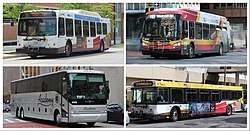 top left: LocalLink, top right: CityLink, bottom left: Commuter, bottom right: Express BusLink | |
| Slogan | 'Linking you to what matters most!' |
|---|---|
| Parent | Maryland Transit Administration |
| Founded | April 30, 1970 |
| Headquarters | 6 St. Paul Street Baltimore, Maryland |
| Locale | Baltimore–Washington metropolitan area |
| Service area | Baltimore-Washington Metropolitan Area |
| Service type | LocalLink, CityLink, Express BusLink, Light RailLink, Metro SubwayLink, Commuter BusLink |
| Routes | LocalLink: 43 CityLink: 12 Express: 9 Commuter: 19 ICC: 4 Total: 87 |
| Hubs | 70+ (Baltimore area) |
| Fleet | Urban bus: 774 Motor coach bus: 68 Total: 842 |
| Daily ridership | 272,700 (Q2 2016)[1] |
| Annual ridership | 81,029,100 (2015)[2] |
| Fuel type | Diesel, Diesel-electric Hybrid |
| Operator | MDOT |
| Chief executive | Kevin Quinn |
| Website | www.mta.maryland.gov |
Operation
The MTA's bus service operates throughout the Baltimore-Washington Metropolitan Area and other parts of the state. These include: 12 City Link High Frequency Color Routes. In addition to LocalLink routes 21 through 95; Express BusLink routes 103, 104, 105, 115, 120, 150, 154, 160, and 164;[3] Intercounty Connector routes 201 through 205; Commuter bus routes 310 through 995.[4] https://mta.maryland.gov/local-bus
Local buses
In June 2017 as part of MD Gov. Larry Hogan's initiative to have a better transit system in Baltimore he launched Baltimore Link.
Local bus lines are identified with a one- or two-digit number. Many of the numerical designations have origins dating back to the days of the Baltimore streetcars and share the route numbers of the respective streetcars that operated along the same streets.
Most local buses operate regular service seven days a week throughout most hours of the day and evening. Some routes operate 24 hours. A small number of routes operate without evening service, on weekdays only, during peak hours only, or only at the times needed for certain employers.[5]
Until 2009, a series of routes operated in the northwest part of the city and suburbs known as Metro connection buses. These routes had designations of the letter M followed by a number, and operated from a Metro station to a specified location or between two Metro stations. When the Metro connection bus service began in 1984, it used designations beginning with the letter M (Mondawmin), R (Rogers Avenue), or P (Plaza), followed by a number. After the Metro was extended to Owings Mills in 1987, only the letter M was used, and it denoted "Metro."
Since 1988, the number of M-lines had declined, as many of them were consolidated, and some were completely eliminated. After the first phase of the Greater Baltimore Bus Initiative took effect in 2005, only seven M-lines remained, though this increased to eight after Route M-6 was restored months later.
Throughout 2008 and 2009, all M-lines were renamed to plain two-digit numerical designations, ranging from 52 to 54 and 56 to 60. During this series of revisions, route changes were also made to some of them, including merging some, splitting others, and completely eliminating part of Route M-17 without any replacement.[6][7]
Express, Commuter, and Intercounty Connector buses
The MTA's express routes should not be confused with the "express" trips assigned to several of the local bus routes. Express routes are dedicated to providing rapid service by limiting the number of stops along the route. The number of express routes has declined over the past two decades as new rapid transit services have been constructed, and poor-performing routes were eliminated or consolidated.
Unlike the commuter buses, express bus routes serve areas where local buses are available. Comparable slower trips can also be accomplished with local buses.[8] Commuter routes, however, provide service between locations not connected by local bus routes.[4]
Both the express and commuter routes, identified with 3-digit numbers, offer limited service mostly during weekday rush hour between downtown Baltimore or Washington and various Park-and-Ride lots or other suburban locations in the state of Maryland. The commuter routes, designated with higher numbers, are operated by contractors rather than MTA employees.[4]
The newest addition to the commuter bus service since 2010, known as Intercounty Connector or ICC for short, operates from Gaithersburg to BWI Marshall Airport, University of Maryland College Park or DoD/Fort Meade, traveling along the newly built Intercounty Connector expressway in central Maryland.
Neighborhood Shuttle Bug
Two of the local routes MTA operates are considered neighborhood shuttles, also known as Shuttle Bugs. These local routes focus on a specific neighborhood and the transportation of persons within these communities.
During the early 2000s, MTA introduced two such routes. These routes, rather than operating like others around town, have differences that include:
- Reduced fare for a single ride: $1.00 rather than the $1.60 charged on regular buses. MTA unlimited ride passes (also known as "GO-passes") also cover the fare.[9]
- In 2006, three shorter, distinctively painted buses, 30-foot Opus buses were purchased and are used exclusively by the Mondawmin shuttle.[10] The Opus buses are the only non 40- and 60-foot buses in MTA's fleet; held at Northwest (4) garage. In mid-2011, MTA retired the three 30-foot Opus buses due to reliability issues.
- Schedules are printed in full color, rather than the monochrome design of most printed schedules, in order to attract more riders.
- Bus stop signs have unique identifications different from usual bus stops. The Hampden Shuttle is identified by a ladybug, and the Mondawmin Shuttle uses the grasshopper symbol.[11]
The Hampden Shuttle Bug was the first of seven shuttle routes originally planned for Baltimore and its suburbs. Only the Hampden and Mondawmin routes were implemented; no timetable was ever set for other neighborhood shuttle routes.[12]
A proposed Shuttle Bug route between Randallstown and the Owings Mills Metro Subway Station was fought by residents along the route the shuttle would take. Objections included that the service would operate on quiet residential streets not accustomed to bus traffic, and area residents did not need the service.[13]
In 2005 and 2006, in various phases of the Greater Baltimore Bus Initiative, MTA proposed various changes to these routes which included routing changes and threats to eliminate Route 98 completely and reduce service on Route 97 to once an hour.[14] The only change that was actually made was a shift on Route 98 in 2008 to replace service on Roland Avenue, that was lost through a change to Route 27.[15]
QuickBus
In 2005, MTA introduced a new form of express transit, known as “rapid bus service.” The first of these services was designated Route 40. The line operates every 10–15 minutes from the western to the eastern suburbs of Baltimore through the downtown area, serving various communities in West and East Baltimore. Stops are limited to major intersections, transfer points, and points of interest. Unlike other express buses, local fares are applicable on Route 40. Route 40 was later named "QuickBus."[16]
In 2009, a new "QuickBus" route was introduced. Designated as QuickBus 48, it operates along the same route as Route 8 minus the section north of Towson Town Center.[6] Introduction of another QuickBus service that would operate along the route Route 3 and would have carry the designation "Route 43", but this proposal was delayed.[17]
Two more QuickBus routes began service on August 30, 2010 until June 17, 2017. QuickBus 46 operates alongside routes 5 and 10 from Paradise Avenue loop to Cedonia Loop. QuickBus 47 travel along the route 15 from Walbrook Junction to Overlea Loop. Both buses operate on weekdays at peak hours only.[18]
Current bus routes
Fares
- See: Current MTA Fares
Fleet roster
Current fleet roster
| Image | Builder | Model | Length (ft/m) | Year | Fuel Propulsion | Powertrain (Engine/Transmission) |
Fleet Numbers (Total) |
Paint Scheme | Notes |
|---|---|---|---|---|---|---|---|---|---|
 |
NABI | 436.07 | 60 ft (18 m) | 1997 | Diesel |
|
9619 (1) |
Comfort Zone Bus |
|
 |
New Flyer | D40LF | 40 ft (12 m) | 2004 | Diesel |
|
04001-04125 (125) |
LocalLink |
|
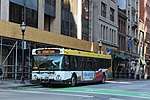 |
New Flyer | D40LF | 40 ft (12 m) | 2005 | Diesel |
|
05001-05094 (94) |
LocalLink | |
 |
New Flyer | DE40LFR | 40 ft (12 m) | 2006 | Hybrid |
|
06001-06010 (10) |
LocalLink |
|
 |
New Flyer | DE60LFR | 60 ft (18 m) | 2008 | Hybrid |
|
08001-08030 (30) |
CityLink | |
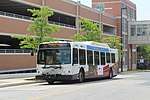 |
New Flyer | DE40LFR[19] | 41 ft (12 m) | 2009 | Hybrid |
|
09001-09100 (100) |
LocalLink | |
 |
New Flyer | DE40LFR[20][21] | 40 ft (12 m) | 2010 | Hybrid |
|
10001-10041 (41) |
LocalLink | |
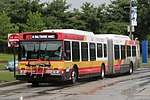 |
New Flyer | DE60LF[22][23] | 60 ft (18 m) | 2010 | Hybrid |
|
11081-11092 (12) |
CityLink | |
 |
MCI | D4500CT[24] | 45 ft (14 m) | 2011 | Diesel |
|
169C-188C (18) |
Commuter
Bus |
|
 |
New Flyer | XDE40[25] | 40 ft (12 m) | 2011 | Hybrid |
|
11001-11057 (57) [25] |
CityLink
LocalLink |
|
 |
New Flyer | XDE40[26][27] | 40 ft (12 m) | 2012 | Hybrid |
|
12001-12053 (53) [27] |
CityLink | |
 |
New Flyer | XDE60 | 60 ft (18 m) | 2013 | Hybrid |
|
12081-12090 (10) |
CityLink |
|
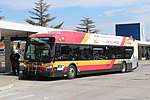 |
New Flyer | XDE40 | 40 ft (12 m) | 2013 | Hybrid |
|
13001-13040 (40) |
CityLink | |
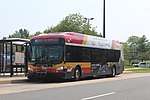 |
|
13041-13050 (10) |
CityLink | ||||||
 |
New Flyer | XDE40[28] | 40 ft (12 m) | 2014 | Hybrid |
|
14001-14041 (41) [28] |
CityLink |
|
 |
New Flyer | XD40[29] | 40 ft (12 m) | 2016-2017 | Diesel |
|
16001-16099, 17000
(100) |
LocalLink
CityLink |
|
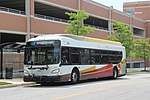 |
New Flyer | XD40 | 40 ft
(12 m) |
2017 | Diesel |
|
17001-17072 (72) |
LocalLink | |
 |
New Flyer | XD40 | 40 ft (12 m) | 2018 | Diesel |
|
18001-18070
(70) |
LocalLink | |
| New Flyer | XD40 | 40 ft (12 m) | 2019 | Diesel |
|
19001- 19070
(70) |
LocalLink |
On Order
| Fleet number(s) | Year | Manufacturer | Model | Notes |
|---|---|---|---|---|
| TBD | 2020-2024 | Nova Bus | LFS / LFS-A |
|
Bus yards
MTA local bus service in Baltimore is divided into four divisions, each served by its own maintenance yard. The first digit of a bus's "block number", attached to the bottom right corner of its windshield (from inside of bus), indicates its "base" division. The buses also feature a small letter suffix to the fleet series number. The letter represent the 'first letter' of the division's "name" from where the bus is based.
| Base (No.) | Base (Letter) | Division | Routes | Yard location[31] |
|---|---|---|---|---|
| 1 | B | Bush Street | NV, OR, GR, BL, SV, RD, YW, PR, BR, 26, 29, 37, 38, 67, 69, 70, 71, 73, 75, 76, 77, 78, 79, 94, 95, 103, 105, 115, 150, 164 | 1515 Washington Blvd. |
| 2 | E | Eastern | NV, OR, BL, LM, GD, 21, 22, 28, 36, 56, 59, 62, 63, 65, 105, 120, 160 | 201 S. Oldham St. |
| 3 | K | Kirk Avenue | GR, PK, RD, PR, BR, 21, 30, 33, 51, 52, 53, 54, 57, 93, 103, 104, 120, 154 | 2226 Kirk Ave. Currently use for Bus Maintenance, until after construction of new Kirk Ave Facility is completed. |
| 4 | N | Northwest | LM, YW, GD, 22, 28, 30, 31, 33, 34, 37, 80, 81, 82, 83, 85, 87, 89, 91, 92, 94 | 4401 Mt. Hope Dr. |
| N/A | N/A | Remington (KIRK AVENUE) | Temporary Facility to store buses for Kirk Division during construction process of PHASE II | 2500 Huntingdon Ave. |
References
- "Transit Ridership Report Second Quarter 2016" (pdf). American Public Transportation Association. August 22, 2016. Retrieved 2016-11-14 – via http://www.apta.com/resources/statistics/Pages/ridershipreport.aspx.
- "Transit Ridership Report Fourth Quarter 2015" (pdf). American Public Transportation Association. March 2, 2016. Retrieved 2016-03-19 – via http://www.apta.com/resources/statistics/Pages/ridershipreport.aspx.
- "Local Bus". MTA Maryland. Retrieved August 17, 2011.
- "Commuter Bus". MTA Maryland. Retrieved August 17, 2011.
- Local Bus Archived 2010-01-18 at the Wayback Machine retrieved 2009-12-16
- MTA Announces New Quickbus Service and Changes to Fall Schedule MTA press release (August 18, 2009). Retrieved 2010-04-23
- MTA Announces Local Bus Service Changes Effective February 17, 2008 MTA press release (December 27, 2007). Retrieved 2010-04-23
- Express Bus Archived 2010-01-18 at the Wayback Machine retrieved 2009-12-16
- Fares Archived 2010-06-17 at the Wayback Machine. MTA Maryland. Retrieved 2010-06-22
- "Governor Ehrlich unveils new buses for Mondawmin shuttle". MTA press release (September 16, 2006). Retrieved 2010-06-18
- "Neighborhood Shuttles". MTA Maryland. Retrieved June 6, 2011.
- Marcia Myers (December 19, 2000). "Neighborhood shuttle service begins with Hampden route". The Baltimore Sun. Retrieved June 6, 2011.
- Joan Jacobson (November 24, 2000). "`Shuttle bug' route proposed to assist people seeking jobs". The Baltimore Sun. Retrieved June 6, 2011.
- Allen Hicks (June 2005). "Residents unhappy about proposed bus changes" (PDF). Historic Hampden Happenings. Hampden Community Council. Archived from the original (PDF) on September 28, 2011. Retrieved June 6, 2011.
- MTA press release (February 11, 2008). "MTA announces winter schedule improvements for bus routes for Baltimore metropolitan region". MTA Maryland. Retrieved June 6, 2011.
- MTA customers to get real-time information at bus stops MTA press release (December 20, 2006). Retrieved 2010-04-23
- Michael Dresser (April 27, 2009). "MTA schedules public meetings on proposed new quick bus routes". The Baltimore sun. Retrieved 2010-04-23.
- "MTA Fall Service Changes". MTA Maryland. Retrieved June 6, 2011.
- New Flyer press release (April 30, 2009). "New Flyer Announces First Quarter 2009 Orders and Backlog". New Flyers Industries, Inc. Archived from the original on August 2, 2009. Retrieved June 6, 2011.
- New Flyer press release (July 16, 2010). "New Flyer Announces Second Quarter 2010 Orders and Backlog". New Flyer Industries Inc. Archived from the original on September 27, 2010. Retrieved June 6, 2011.
- MDOT press release (November 15, 2010). "Transition to all-hybrid MTA bus fleet continues". Maryland Department of Transportation. Retrieved August 11, 2011.
- New Flyer press release (January 20, 2011). "New Flyer Announces Fourth Quarter 2010 Orders and Backlog". New Flyer Industries, Inc. Archived from the original on July 14, 2011. Retrieved June 6, 2011.
- "Governor O'Malley announces more hybrid buses added to MTA fleet". Maryland Department of Transportation press release. August 4, 2011. Retrieved August 11, 2011.
- MCI press release (February 14, 2011). "Maryland Transit Administration goes with 18 MCI Commuter Coaches for new ICC toll road". Motor Coach Industries Inc. Archived from the original on October 14, 2011. Retrieved October 1, 2011.
- "Monumentalcity.net btco.net Forum - Xcelsior". September 21, 2011. p. 5. Archived from the original on April 6, 2012. Retrieved September 23, 2011.
- "Hybrid diesel electric transit buses". MTA Maryland press release. June 21, 2012. Retrieved July 8, 2012.
- "Maryland's Draft FY 2013-2018 Consolidated Transportation Program". Maryland Department of Transportation. September 6, 2012. Retrieved September 12, 2012.
- "Facebook".
- "Baltimore Award New Flyer Contract for 172 Xcelsior Buses". New Flyer News release. March 8, 2016. Archived from the original on March 13, 2016. Retrieved March 13, 2016.
- http://bpw.maryland.gov/Documents/Supplementals/SUPP%20DOT%2021%20MTA%20Bus%20Buy.pdf%5B%5D
- "2010-2011 MTA Media Guide" (PDF). MTA Maryland. August 2010. p. 2. Retrieved June 6, 2011.